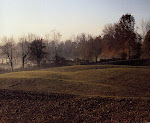Throughout term two we have been working on and developing ideas towards creating our own Vanita. This process invloves finding objects, which you don't necessarily have to own, which mean something to you, or are part of your life. I thought of multiple objects or things which I would like to use in my Vanita. These include:
>Teddy Bear
>Bracelet
>Mini Boat
>Laptop
>Ipod
>Tennis Racquet
>Watch
Once these items are all photographed and loaded onto the computer I can print them out and paste them on to my Vanita, or use photoshop. I can also get images from the internet to add. Before any of this can be done, I have to choose a Vanita to use. I chose a vanita with a vase of flowers. I don't really like the Vanitas with the skulls because they are not very nice to look at. Although flowers symbolise death as well, they usually appear bright and cheerful, therefore a more lighthearted image of death than the skull.
When choosing a Vanita, it is important to think about it's meaning. Vanitas use visual language to give the viewer an insight into what it means, and it's story. It is made up of symbols which each contribute to the meaning of the painting. The colour used is also an important aspect, in the Vanita above the colour which stands out is the blue, giving a cold/cool feeling. The Vanita's temperature (cool/warm) is dependant on the colours used. When painting a vanita the canvas is first painted a colour, either warm or cool, and then painted black over the top. The reason for this is that the underlying colour gives the black a feeling of colour. A blue would make the black look cold, even though it is not obvious that there is any blue at all. Our class has started painting their canvases the colour of their choice and then proceeding to paint black over the top.
It is not just the colour of the Vanita which creates mood, but the tone, texture, and shapes used as well. Shadows are created to give a feeling of light or darkness, and helps to make the images look three dimensional. In the Vanita above the shadow is being cast from the front of the skull which tells us that the light is coming from the front left of the canvas, the butterflies are also casting shadows. Shading has been used on the edges of the skull where there is no, or little light, like inside the eyes and nose. As mentioned above, texture is used in Vanitas to tell the viewer whether certain surfaces are rough or smooth. This adds to the realism of the artwork. When we practise painting images we practise the visual language so that when we do our final work, it will look as best as it can.
I am looking forward to getting started on our final piece. It will be a challenge, but I think that it will help us a lot in learning about painting. However if we didn't get to add our own items into the painting then I wouldn't like it much at all. I really enjoy choosing the images which could be included and how they should be placed in the picture.

.jpg)
1 comment:
Good work Catherine, but don't stop here ... you really need to do more sample paintings before you will be ready to paint but you are running out of time. I suggest you use homework time to do this over the next few weeks.
ms h
Post a Comment